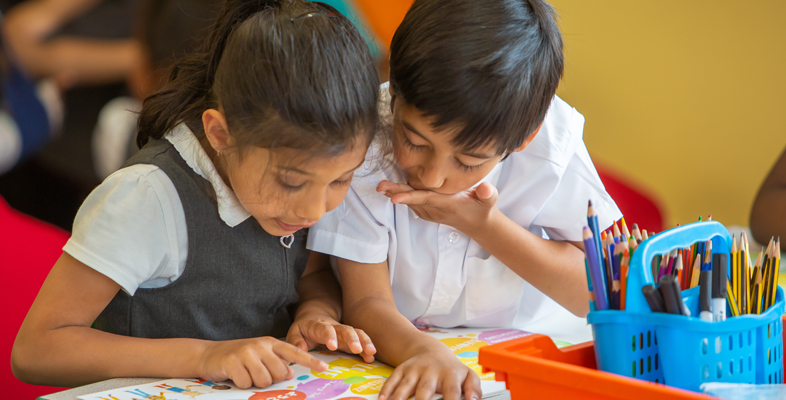1.1 Engaging RfP ‘disadvantaged’ readers
The reasons for children’s underachievement and lack of engagement in reading are always complex and it is beyond the remit of this course to examine readers challenged by dyslexia or other reading difficulties. Instead, the focus here is on those readers who, for complex reasons, have not yet found what ‘reading is good for’ (Meek, 1998). They may even be striving readers (a term increasingly used in Singapore to describe ‘reluctant’ readers), who are waiting to or wanting to experience the excitement found in reading. However, without the driving force of affect and deep emotional engagement in the subject matter, they may never gain the satisfactions or benefits that reading offers.
Labelling children ‘reluctant’ or ‘unwilling’ is unhelpful as terms hold significance and tend to place the onus on the child. In fact, developing readers is a responsibility shared between the school community, the teachers, families, parents and the child.
Some children are arguably Reading for Pleasure ‘disadvantaged’. The term ‘disadvantaged’ is often understood to mean those children who are eligible for additional funding, free school meals and so on, but this is not a key criterion for Reading for Pleasure. Those who are Reading for Pleasure ‘disadvantaged’ are the children who:
- are not often read-to and do not share books with others beyond school
- do not show that they are engaged or interested in reading
- may be falling behind in their reading skills (including phonics)
- may be capable readers who choose not to read.
These children may hide their lack of assurance and negative attitudes by avoidance tactics or by messing around when it is time to read. However, if they can encounter the enjoyment to be had in reading, and can achieve their own goals as readers, they could become striving readers.

SAQ _unit9.1.1 Personal reflection 1
Reading Teachers who reflect on their own childhood reluctance to engage in particular areas of the curriculum will understand the emotions and disaffection involved.
Think back to your own childhood and make a note of the area of education in which you were least assured. Perhaps you were reluctant to engage fully in mathematics, geography, history, science, drama, dance, art, RE or PE. How did that subject make you feel? What were your attitudes towards it? Do you still feel that way? What did you do in school or at home that characterised your reluctance?
Comment
You may have noted a lack of confidence in sport for instance, and recall trying but not succeeding at running or gymnastics. Over time, you may have begun to think ‘I can’t do this, so I don’t really care about it’ and gradually distanced yourself from the subject due to your low self-efficacy. Disheartened and lacking the assurance to give it another go, this pattern towards sport may have lasted several years, even a lifetime thus far perhaps?
Disengaged readers need considerable support to alter the status quo, particularly before they leave primary school. Without such support they will not be able to fully access the secondary curriculum. They will not achieve as highly as their peers who read recreationally (Sullivan and Brown, 2015) and as a result their life chances are likely to be short-changed.
Less engaged readers need additional opportunities to hear stories, to read with and to others, as well as a space to talk about the texts they are reading in an informal low-key manner, without assessment or judgement. As they may also perceive reading as book-bound, you will want to broaden what counts as reading in their eyes and get to know them well as readers (as discussed in Session 4). This will include offering relaxed opportunities and sensitive scaffolding that seeks to pique their interests and improve their self-esteem and attitudes towards reading. It will also involve ensuring they have access to books and activities that are relevant to them and their reading goals. Your RfP pedagogy needs to be finely tuned to these readers and you will want to monitor their response and engagement. Box 1 lists five tips on how to engage disadvantaged readers.
Box _unit9.1.1 Box 1 How to engage RfP ‘disadvantaged’ readers
Follow these five simple tips:
- Get to know your striving/‘reluctant’/RfP ‘disadvantaged’ readers well: take time to notice, document, reflect and act.
- Let them choose what they want to read and offer support. Books or magazines linked to films and computer games may prove popular with some, comics, graphic novels or non-fiction with others, depending on their interests. Each reader is unique.
- Offer them additional relaxed opportunities to hear stories.
- Draw them into reading and talking about texts in common in small groups.
- Ensure successful engagement in reading by supporting their skills and the will to read and avoiding any sense of reading being a competition.
In summary, ‘reluctant’/striving/‘disadvantaged’ readers need what all readers need, but in every case they need much more of it. They need to be:
- supported by teachers who have a good working knowledge of children's texts, and who enable and support children’s access to texts
- supported by teachers who make the time to get closely acquainted with their personal interests and practices beyond school, and help them choose texts that tempt
- invited into the engaging world of reading by a rich RfP pedagogy and Reading Teachers who are determined to find ways to motivate them.
The Further resources section at the end of this session provides a link to more guidance and resources to help you support readers who have fallen behind due to reluctance or other reading difficulties.
